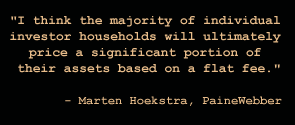|
Flat-fee brokerage and you
|
 |
December 7, 1999: 6:36 a.m. ET
Big-name firms offer advice, fixed fees, online trading -- but are they for you?
By Staff Writer Alex Frew McMillan
|
NEW YORK (CNNfn) - With the explosion of options about how to invest and the range of commissions on trades, picking a broker sometimes seems more complicated than busting out your high-school math books and knocking out a few calculus problems.
Wall Street’s biggest brokerages hope they have the answer: The flat-fee account.
Flat-fee brokerage accounts appeal to customers who want to know exactly how much they’re paying and for what, a variation on the fee-based wrap accounts that E.F. Hutton pioneered in the ‘70s. For a set share of your assets each year, the full-service brokerage promises access to a broker/financial adviser, proprietary research from the brokerage’s investment bank and unlimited online trading -- virtually, the small print says.

The new flat-fee accounts are the full-service brokers’ response to discount online brokers offering trades for as little as $5 a pop. By combining full service and online trading, the big boys hope to blend the convenience of the Internet with advice and financial planning.
Merrill Lynch, Morgan Stanley Dean Witter, PaineWebber, Prudential Securities and Salomon Smith Barney have all rolled out flat-fee accounts that include online trading this year, sometimes amid great fanfare and extensive advertising. Sure, they want you. But do you want them?
Simpler, clearer pricing
One of the main attractions of flat-fee accounts is that they make brokerage fees easier to understand. There are no variable commissions to haggle over. The percentage of your assets is set at the start of the year, and the fees are often paid quarterly.
Many investors are clearly dissatisfied with traditional brokers and the high fees they charge, often shrouded in discounts and negotiated rates. That dissatisfaction has helped fuel self-directed online trading’s burst of popularity.
In response, the full-service brokers hope to attract skeptical clients who think commission-based brokers will sell them anything to earn their dinner. At the same time, they want to guarantee their own brokers -- threatened with death by Internet -- a stream of fees.
In theory, you and your financial adviser’s interests are aligned with a fee-based account. The broker’s take grows as your assets grow. Not even budget online brokerages, which have an incentive to boost trading and thereby their commissions, can make that claim.
"What fee-based business does, in general, is it really aligns everybody’s incentives,” said Pam Parker, director of Salomon’s AssetOne program. "As the assets increase, everybody is happy, and everybody is rewarded commensurately.”
At the moment, most investors who have switched to fee-based accounts are just experimenting. In many cases, the accounts are better suited to wealthier customers who have active investing strategies. But the industry hopes to convert many different kinds of investors to full-service fee accounts.
"I think the majority of individual investor households will ultimately price a significant portion of their assets based on a flat fee,” said Marten Hoekstra, director of marketing services for PaineWebber and its InsightOne account. "They like the simplicity, the predictability, and the notion that it creates a very clear, long-term consulting relationship.”
This is still no flat tax
The cost of a flat-fee account isn’t set in stone, though. The annual percentage varies from brokerage to brokerage and depends on the type of assets you have. Equities are more complex than fixed-income investments or cash to manage, so you will almost always find that the flat fee is greater on equities.
Merrill Lynch’s Unlimited Advantage account, for instance, has one of the simplest pricing structures. The annual fee is 1 percent of any equities and 0.3 percent of cash and fixed-income assets. So nearly all customers end up with a fee of less than 1 percent a year, but it depends on their asset mix.
With other full-service brokerages, the flat fee also varies depending on how much money you have under management in the account. The Prudential Advisor account, for instance, ranges from 1.5 percent to 0.25 percent as your assets increase.

Salomon and PaineWebber also still allow you to negotiate the annual percentage with the financial adviser. The flat fee at Salomon and PaineWebber ranges from 0.75 percent to 1.5 percent a year on equities, depending on how much you expect to trade, the amount of meetings and contact you want with your broker, and the number of portfolio reviews you expect a year.
Many of the accounts require a minimum balance, though Merrill doesn’t. Morgan Stanley’s minimum is $50,000 in investable assets, while Salomon, PaineWebber and Prudential set the bottom asset rung at $100,000. That can be in a number of accounts, including IRAs, a uniform gift to minors account, a regular trading account and so on.
But Merrill still charges a minimum fee of $1,500 a year, as do many of its peers. In other words, if you have less than $150,000 under management, you’re paying more than 1 percent a year. For Morgan Stanley’s Choice account, the minimum annual fee is $1,000.
So they’re not for everyone
Those kind of restrictions mean flat-fee accounts are typically best suited for anyone with assets of at least $100,000, even if there isn’t a minimum balance, according to Dee Lee, a 401(k) expert and financial planner who runs financial workshops through her company, Harvard Financial Educators.
"If you’ve got under $100,000, it’s very difficult to be diversified,” she said. So you’re less likely to have an active investing strategy and to need regular financial advice. "You’d do just as well to be in a bunch of mutual funds,” she said, paying an independent financial adviser hourly when you want to talk to one.
The new flat-fee accounts are different from the "wrap accounts” E.F. Hutton -- now part of Salomon -- started in that they’re still self-directed. In other words, the investor still makes the investment decisions and takes responsibility for managing the account, albeit in conjunction with a financial adviser’s input.
Traditional wrap accounts are discretionary accounts. The client and the financial adviser pick a money manager or group of managers. The money managers, often outside the brokerage, take control of investing the assets. The fee is correspondingly higher, ranging up to 3 percent. The new flat-fee accounts are designed for people who still want to be directly involved in managing their money but think they need a financial adviser.
That often happens as investors’ financial position gets more complicated -- through higher salaries, stock options, family planning issues or estate-planning considerations. Plus, "having a financial planner is getting to be a status symbol,” Lee said.
The new flat-fee accounts compete with independent investment advisers, Lee said, and brokerages such as Charles Schwab, where an investor can pay 1 percent of assets a year to work with an independent financial adviser.
The full-service firms have an edge in that, except for Prudential, which still charges $29.95 for online trades through Prudential Advisor, they waive trading commissions. Customers using independent financial advisers still have to pay commissions at the brokerage that the adviser uses.

Life could get a little tricky for independent financial advisers in light of these accounts, admitted Kyra Morris, a certified financial planner who runs Morris Financial Concepts in the Charleston, S.C., suburb of Mount Pleasant.
"It’s very similar to what I’ve been offering for a very long time,” she said. She charges her 80 clients a minimum fee of $3,500 a year. She can’t avoid the commission costs of operating through a broker -- she mainly uses Schwab -- and aims to keep her annual fee at 1.5 percent to 2 percent of her clients’ assets.
She isn’t worried because she has a small, set base of customers that she knows well and a local reputation. "With my clients, if you mention their names, it’s like I’m part of their family,” she said. "I compete by watching my fees and on the service side.” She thinks she recalls her customers’ individual situations well and can offer more personal attention.
It’s a personal choice whether a big full-service brokerage or an independent adviser works best for you. It also depends on how well you get to know your financial adviser at one of the big companies. "Some people like to go to Macy’s, and other people like to go to a small shop downtown,” Lee said.
Caveats to bear in mind
Flat-fee accounts have definite appeal to a wide range of customers, but even the full-service brokerages admit they’re not for everyone. Most brokerages will step in to stop extremely active and day traders from abusing the accounts by running up large commissions on a small balance, the reason the brokerages say trading is "virtually” unlimited.
There are also clauses to stop investors from shuffling assets in and out to avoid the fees. To close out an account mid-year, you likely will have to pay the lower of the fees due for the rest of the year or the difference between the fees you’ve paid and the commissions you would have run up in a normal account. The policy is designed to stop someone using a flat-fee account for short-term active trading.
These are designed as accounts for long-term, reasonably affluent customers. If you aren’t an active-enough investor or don’t have enough investable assets to make the minimum fees worthwhile, consider sticking with a discount or online broker.
And there’s no free lunch. "Their service models and cost structures continue to be driven by highly paid brokers,” said Marta von Loewenfeldt, a spokeswoman for Schwab. "Commissions have been replaced by fees, and the vast majority of customers will not be better off.” For most people, she believes a discount online trader -- like her firm and its competitors -- is better value.
Lee said that even though you may have the minimum balance for a flat-fee account, you may be better on your own or paying a financial adviser by the hour if you want occasional advice. "If you do one trade a year, you’re buy and hold, you’re comfortable with what you’ve already done, why pay 1 percent?” she said.
She added that it’s important the financial adviser understands your position and lifestyle. Watch that you don’t end up shunted from broker to broker as they whirl through a revolving door at a large company.
Morris, the independent financial adviser, said people who have left Merrill and come to her complain that they feel their broker didn’t understand their portfolio and would shuffle them to another person at the company to answer many of their questions.
But the flat-fee idea is popular -- Merrill has signed up 200,000 accounts in Unlimited Advantage since July. Both Prudential and PaineWebber have around $3 billion in assets in their flat-fee programs since they launched them in May and October, respectively.
And for good reason, Lee said. She thinks these programs are highly worthwhile if they deliver on the personal attention and disinterested advice they promise. Most people can benefit from a financial adviser "whether you’re making $30,000 or $300,000, " she said.
The real math problem to consider is if you’re better off paying by the hour or developing a round-the-year relationship, she said. "If you want an ongoing situation, this is for you,” she said. 
|
|
|
|
|
 |

|

